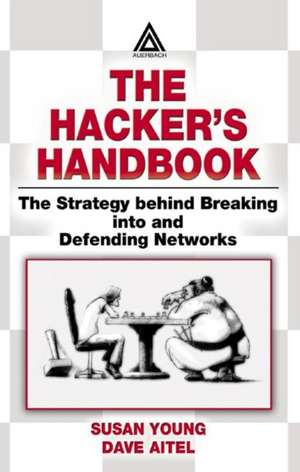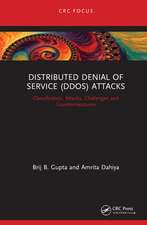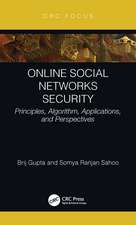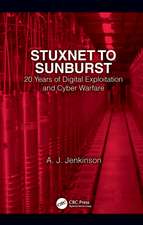The Hacker's Handbook: The Strategy Behind Breaking into and Defending Networks
Autor Susan Young, Dave Aitelen Limba Engleză Hardback – 24 noi 2003
Each section provides a “path” to hacking/security Web sites and other resources that augment existing content. Referencing these supplemental and constantly-updated resources ensures that this volume remains timely and enduring. By informing IT professionals how to think like hackers, this book serves as a valuable weapon in the fight to protect digital assets.
Preț: 688.76 lei
Preț vechi: 1030.01 lei
-33% Nou
Puncte Express: 1033
Preț estimativ în valută:
131.84€ • 143.25$ • 110.81£
131.84€ • 143.25$ • 110.81£
Carte tipărită la comandă
Livrare economică 21 aprilie-05 mai
Preluare comenzi: 021 569.72.76
Specificații
ISBN-13: 9780849308888
ISBN-10: 0849308887
Pagini: 894
Ilustrații: 195 black & white illustrations, 246 black & white tables
Dimensiuni: 156 x 234 x 52 mm
Greutate: 1.37 kg
Ediția:New.
Editura: CRC Press
Colecția Auerbach Publications
ISBN-10: 0849308887
Pagini: 894
Ilustrații: 195 black & white illustrations, 246 black & white tables
Dimensiuni: 156 x 234 x 52 mm
Greutate: 1.37 kg
Ediția:New.
Editura: CRC Press
Colecția Auerbach Publications
Public țintă
Academic, Professional, and Professional Practice & DevelopmentCuprins
Preface. Case Study in Subversion. Know Your Opponent. Anatomy of an Attack. Your Defensive Arsenal. Programming. The Protocols. Domain Name Service. Directory Services. Simple Mail Transfer Protocol. Hypertext Transfer Protocol. Database Hacking. Malware. Network Hardware. Consolidating Gains. After the Fall. Conclusion.
Recenzii
“By the author’s providing a ‘hacker’ perspective, readers will more fully understand the ramifications of having an insecure computer, server, network, program, database and or policy. The book [includes] … a good table of contents that is extensive, very organized and thorough … . … [T]here are important discussions of the non-technical kind [of insecurity] like policy, which is too often overlooked in many organizations. … What is most impressive about the book is its outlines of specific exploits and attacks with prescribed defenses. … Coupled with good illustrations and detailed explanations[,] this is a great resource for both academic and public libraries.”
— E-Streams, Vol. 7, No. 9, Sept. 2004
“Awesome work!”
—Anton Chuvakin, Ph.D., GCIA, GCIH, netForensics
Promo Copy
— E-Streams, Vol. 7, No. 9, Sept. 2004
“Awesome work!”
—Anton Chuvakin, Ph.D., GCIA, GCIH, netForensics
Promo Copy
Notă biografică
Dave Aitel is the founder of Immunity, Inc. (www.immunitysec.com), with prior experience at both private industry security consulting companies and the National Security Agency. His tools, SPIKE and SPIKE Proxy, are widely regarded as the best black box application assessment tools available.Susan Young has worked in the security field for the past seven years, four of which have been spent in the security consulting arena, helping clients design and implement secure networks, training on security technologies, and conducting security assessments and penetration tests of client system or network defenses (so-called ethical hacking). Her experience has included consulting work in the defense sector and the financial industry, as well as time spent evaluating and deconstructing various security products. She currently works as a senior security consultant in the Boston area security practice of International Network Services (INS).
Descriere
This handbook reveals those aspects of hacking least understood by network administrators. It analyzes subjects through a hacking/security dichotomy that details hacking maneuvers and defenses in the same context. Chapters are organized around specific components and tasks, providing theoretical background that prepares network defenders for the always-changing tools and techniques of intruders. Part I introduces programming, protocol, and attack concepts. Part II addresses subject areas (protocols, services, technologies, etc.) that may be vulnerable. Part III details consolidation activities that hackers may use following penetration.


























